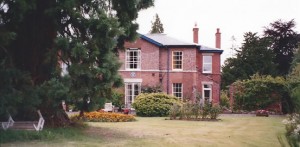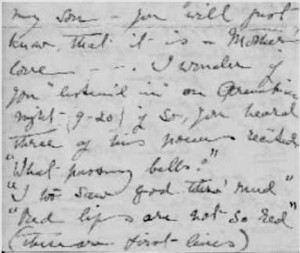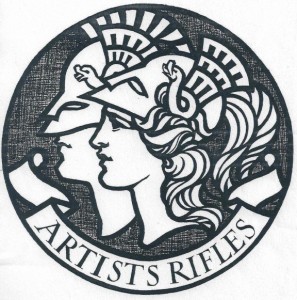Owen’s literary stature and reputation
Born in Oswestry Owen developed an early, informed and practised interest in literature, particularly poetry. There were many influences on his work – romantic poets, particularly Keats; biblical knowledge; love and respect for nature and humanity. It is however generally agreed that the most profound influences were his experiences of war. Military action, breakdown, meetings with like poetic minds, recovery and return to the front – all greatly affected his choice of subject matter and his treatment of it. Little of his work was published in his lifetime. Following his untimely death in action and the end of the First World War friends collected and published some of his work in 1920. Since then his literary stature has been established internationally. Visiting www.wilfredowen.org.uk will give access to much that has unfolded since 1920.
Oswestry connections : Plas Wilmot
(Click on Image to Enlarge)
 Owen was born at Plas Wilmot. A commemorative blue plaque has been placed at the back of the house. A bedroom close to the plaque – centre of the picture to the left – has been described as the birth room. The property has changed hands several times since it was built by Owen’s grandfather, Edward Shaw. One later owner made major internal alterations and it is thought a staircase was moved during those alterations. What is now described as the birth room may well be a later creation on the original landing of the first staircase.
Owen was born at Plas Wilmot. A commemorative blue plaque has been placed at the back of the house. A bedroom close to the plaque – centre of the picture to the left – has been described as the birth room. The property has changed hands several times since it was built by Owen’s grandfather, Edward Shaw. One later owner made major internal alterations and it is thought a staircase was moved during those alterations. What is now described as the birth room may well be a later creation on the original landing of the first staircase.
Among later owners were the Phillips and Park families. Owen’s mother Susan held fond memories of Oswestry and Plas Wilmot. Some evidence of this is in her correspondence in October 1932 with Mrs Phillips, then living at Plas Wilmot and wife of the librarian. This correspondence led to Edward Shaw’s notebook, kept while Plas Wilmot was being built, being given to Oswestry library where it is still kept.
(Click on Image to Enlarge)
Correspondence between Mrs. Owen and Mrs. Philips helps identify what must be one  of the earliest broadcasts of Owen’s poems. Writing on14th Nov 1932 Susan asks If Mrs Phillips had “listened in” on Armistice night. The extract to the right identifies some of her son’s poems which were broadcast.
of the earliest broadcasts of Owen’s poems. Writing on14th Nov 1932 Susan asks If Mrs Phillips had “listened in” on Armistice night. The extract to the right identifies some of her son’s poems which were broadcast.
The Radio Times of 4th of November 1932 bears out Susan’s account.
Private Reading at Plas Wilmot
(Click on Image to Enlarge)
On 26th November 1973 four members of the RSC gave selected readings from Owen’s letters and poems at Plas Wilmot. This was during the ownership of Drs Bill and Ann Park. The readers were Robin Bailey, Fulton Mackay, Sheila Manahan, and John Phillips, perhaps better known to most people as television and theatre stars. The readers gave Bill and Anne a signed copy of their script. Linking narration was based on Edmund Blunden’s memoir and the text of the poems was from the edition by Cecil Day Lewis
Commemoration on the Broadwalk
(Click on Image to Enlarge)
 Owen enlisted in the Artists Rifles in 1916. The regimental badge shows Mars, god of war, and Minerva goddess of wisdom. The badge is featured on the commemorative plaque installed in the Broadwalk on 19th March 1993. Other elements recognise Owen as poet, soldier and Oswestrian. The featured poems are Anthem for Doomed Youth and Futility which were read to the assembled company by the then Poet Laureate, Ted Hughes.
Owen enlisted in the Artists Rifles in 1916. The regimental badge shows Mars, god of war, and Minerva goddess of wisdom. The badge is featured on the commemorative plaque installed in the Broadwalk on 19th March 1993. Other elements recognise Owen as poet, soldier and Oswestrian. The featured poems are Anthem for Doomed Youth and Futility which were read to the assembled company by the then Poet Laureate, Ted Hughes.
Oswestry Library has a folder on Wilfred Owen. It includes some reports on presentations and performances of Owen’s works. It has detail that lies outside the scope of usual academic and literary work but is a useful source for those who wish to gain an understanding of the range and extent of interest Owen’s work has stimulated.
©Charles Stiles 2012
This article is copyrighted, please contact the group before using any information or pictures, held in this article.

